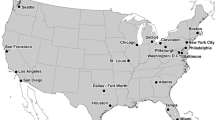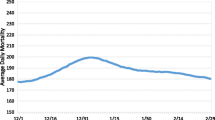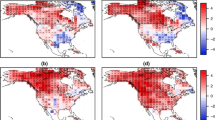Abstract
Due to a number of complicating factors, cold-related mortality has long been understudied. Through a synoptic climatological, environment-to-circulation perspective, this research takes a unique approach in examining anomalous surface temperature and pressure map patterns associated with the days leading up to high-mortality, spike days for Chicago, Illinois during the cold season. Atmospheric conditions leading to spike days during the cold season were evaluated through both seasonal anomaly and 1-day anomaly maps. Results indicate that high-mortality days are typically preceded by unseasonably cold weather situated over the region from 2 to 5 days beforehand, with significantly higher than average pressure 1 to 2 days before a mortality spike. As this system moves eastward, a significant 1-day warming trend accompanying a significant drop in sea level pressure follows—occurring on the day of the mortality spike or 1 day prior. Both scenarios—cold, high pressure air exposure and the rapid change in weather—are consistent with previous literature connecting them as factors contributing to cold-related mortality increases, with this sequence possibly playing a key role in yielding mortality levels anomalous enough to meet the threshold for a spike.





Similar content being viewed by others
References
Allen MJ, Sheridan SC (2013) High-mortality days during the winter season: comparing meteorological conditions across 5 U.S. cities. Int J Biometeorol. doi:10.1007/s00484-013-0640-4
Analitis A, Katsouyanni K, Biggeri A, Baccini M, Forsberg B, Bisanti L, Kirchmayer U, Ballester F, Cadum E, Goodman PG, Hojs A, Sunyer J, Tiittanen P, Michelozzi P (2008) Effects of cold weather on mortality: results from 15 European cities within the PHEWE project. Am J Epidemiol 168:1397–1408
Anderson BG, Bell ML (2009) Weather-related mortality: how heat, cold, and heat waves affect mortality in the United States. Epidemiology 20:205–213
Armstrong B (2006) Models for the relationship between ambient temperature and daily mortality. Epidemiology 17:624–631
Ballester F, Corella D, Pérez-Hoyos S, Sáez M, Hervás A (1997) Mortality as a function of temperature. A study in Valencia, Spain, 1991–1993. Int J Epidemiol 26:551–561
Basu R, Samet JM (2002) Relation between elevated ambient temperature and mortality: a review of the epidemiological evidence. Epidemiol Rev 24:190–202
Braga ALF, Zanobetti A, Schwartz J (2002) The effect of weather on respiratory and cardiovascular deaths in 12 U.S. cities. Environ Health Perspect 110(9):859–863
Coleman JSM (2010) The human mortality response to synoptic scale atmospheric circulation changes in the transitional seasons. Prof Geogr 60:190–206
Curriero FC, Heiner KS, Samet JM, Zeger SL, Strug L, Patz JA (2002) Temperature and mortality in 11 cities of the Eastern United States. Am J Epidemiol 155:80–87
Diaz J, Garcia R, Lopez C, Linares C, Tobias A, Prieto L (2005) Mortality impact of extreme winter temperatures. Int J Biometeorol 49:179–183
Dominici F, McDermott A, Zeger SL, Samet JM (2003) Airborne particulate matter and mortality: timescale effects in four US cities. Am J Epidemiol 157:1055–1065
Ebi KL, Exuzides KA, Lau E, Kelsh M, Barnston A (2004) Weather changes associated with hospitalizations for cardiovascular diseases and stroke in California, 1983–1998. Int J Biometeorol 49:48–58
Eccles R (2002) An explanation for the seasonality of acute upper respiratory tract viral infections. Acta Otolaryngol 122:183–191
Gasparrini A (2011) Distributed lag linear and non-linear models in R: the package dlnm. J Stat Softw 43:1–20
Gasparrini A, Armstrong B, Kenward MG (2010) Distributed lag non-linear models. Stat Med 29:2224–2234
Geber Y, Jacobsen SJ, Killian JM, Weston SA, Roger VL (2006) Seasonality and daily weather conditions in relation to myocardial infarction and sudden cardiac death in Olmstead County, Minnesote, 1979-2002. Am J Cardiol 48:287–292
Gorjanc ML, Flanders WD, VanDerslice J, Hersh J, Malilay J (1999) Effects of temperature and snowfall on mortality in Pennsylvania. Am J Epidemiol 149:1152–1160
Gosai A, Salinger J, Dirks K (2009) Climate and respiratory disease in Auckland, New Zealand. Aust NZ J Public Health 33:521–526
Gosling SN, Lowe JA, McGregor GR, Pelling M, Malamud BD (2009) Associations between elevated atmospheric temperature and human mortality: a critical review of the literature. Clim Chang 92:299–341
Hajat S, Kovats RS, Lachowycz K (2007) Heat-related and cold-related deaths in England and Wales: who is at risk? Occup Environ Med 64:93–100
Huynen MM, Martens P, Schram D, Weijenberg MP, Kunst AE (2001) The impact of heat waves and cold spells on mortality rates in the Dutch population. Environ Health Perspect 109:463–470
Kalnay E, Kanamitsu M, Kistler R, Collins W, Deaven D, Gandin L, Iredell M, Saha S, White G, Woollen J, Zhu Y, Chelliah M, Ebisuzaki W, Higgins W, Janowiak J, Mo KC, Ropelewski C, Wang J, Leetmaa A, Reynolds R, Jenne R, Joseph D (1996) The NCEO/NCAR 40-year reanalysis project. Bull Am Meteorol Soc 77:437–470
Keatinge WR (2002) Winter mortality and its causes. Int J Circumpolar Health 61:292–299
Keatinge WR, Coleshaw SR, Cotter F, Mattock MB, Murphy M, Chelliah R (1984) Increases in platelet and red cell counts, blood viscosity, and arterial pressure during mild surface cooling: factors in mortality from coronary and cerebral thrombosis in winter. Br Med J (Clin Res Ed) 289:1405–1408
Koppe C, Jendritzky G, Kovats RS, Menne B (2004) Heat waves: risks and responses. Health and global environmental changes, 2. WHO Regional Office for Europe, Copenhagen
Kunst AE, Looman CWN, Mackenbach JP (1993) Outdoor air temperature and mortality in the Netherlands: a time-series analysis. Am J Epidemiol 137:331–341
Kyobutungi C, Grau A, Stieglbauer G, Becher H (2005) Absolute temperature changes and stroke risk: a case-crossover study. Eur J Epidemiol 20:693–698
Lee CC, Sheridan SC, Lin S (2012) Relating weather types to asthma-related hospital admissions in New York state. Ecohealth. doi:10.1007/s10393-012-0805-5
Mäkinen TM, Juvonen R, Jokelainen J, Harju TH, Peitso A, Bloigu A, Silvennoinen-Kassinen S, Leinonen M, Hassi J (2009) Cold temperature and low humidity are associated with increased occurrence of respiratory tract infections. Respir Med 103:456–462
McGregor GR (1999) Winter ischemic heart disease deaths in Birmingham, United Kingdom: a synoptic climatological analysis. Clim Res 13:17–31
Medina-Ramón M, Schwartz J (2007) Temperature, temperature extremes and mortality: a study of acclimatisation and effect modification in 50 US cities. Occup Environ Med 64:827–833
Miniño AM, Murphy SL (2012) Death in the United States, 2010. NCHS data brief, no 99. National Center for Health Statistics, Hyattsville, MD
Morabito M, Crisci A, Orlandini S, Maracchi G, Gensini GF, Modesti PA (2008) A synoptic approach to weather conditions discloses a relationship with ambulator blood pressure in hypertensives. Am J Hypertens 21:748–752
O’Neil MS, Zanobetti A, Schwartz J (2003) Modifiers of the temperature and mortality association in seven U.S. cities. Am J Epidemiol 157:1074–1082
Plavcová E, Kyselý J (2010) Relationships between sudden weather changes in summer and mortality in the Czech Republic, 1986–2005. Int J Biometeorol 54:539–551
Plavcová E, Kyselý J (2013) Effects of sudden air pressure changes on hospital admissions for cardiovascular diseases in Prague, 1994–2009. Int J Biometeorol. doi:10.1007/s00484-013-0735-y
Schwartz J (2005) Who is sensitive to extremes of temperature? A case-only approach. Epidemiology 16:67–72
The Eurowinter Group (1997) Cold exposure and winter mortality from ischaemic heart disease, cerebrovascular disease, respiratory disease, and all causes in warm and cold regions of Europe. The Lancet 349: 1341–1346
Von Storch H, Zwiers FW (2004) Statistical analysis in climate research. Press Syndicate, Cambridge University Press, Inc, Cambridge, United Kingdom
Yarnal B (1993) Synoptic climatology in environmental analysis: a primer. Belhaven Press, London and CRC Press, Inc, Boca Raton, Florida, USA
Author information
Authors and Affiliations
Corresponding author
Rights and permissions
About this article
Cite this article
Allen, M.J., Lee, C.C. Investigating high mortality during the cold season: mapping mean weather patterns of temperature and pressure. Theor Appl Climatol 118, 419–428 (2014). https://doi.org/10.1007/s00704-013-1075-x
Received:
Accepted:
Published:
Issue Date:
DOI: https://doi.org/10.1007/s00704-013-1075-x




